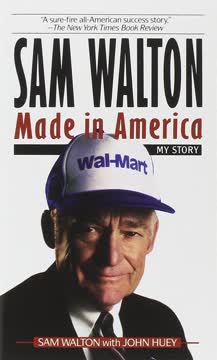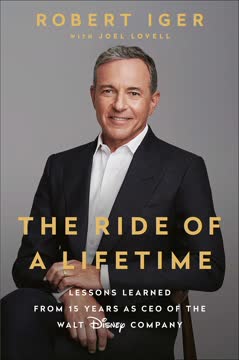Key Takeaways
1. Embrace innovation and disrupt yourself before others do
Innovate or die, and there's no innovation if you operate out of fear of the new or untested.
Constant innovation is crucial. In today's rapidly changing business landscape, companies must be willing to disrupt their own successful models before external forces do it for them. This requires a balance of respecting tradition while embracing new ideas and technologies.
Examples of self-disruption:
- Disney's shift to direct-to-consumer streaming services
- Acquisition of tech-savvy companies like Pixar and Marvel
- Investment in BAMTech to build streaming capabilities
Key strategies:
- Encourage a culture of experimentation and risk-taking
- Stay attuned to emerging trends and technologies
- Be willing to cannibalize existing revenue streams for future growth
2. Take calculated risks and trust your instincts in major decisions
A company's success depends on setting high ethical standards for all things, big and small. Another way of saying this is: The way you do anything is the way you do everything.
Bold decision-making is essential. While data and analysis are important, leaders must also trust their instincts when making major decisions. This requires a combination of thorough research, careful consideration, and the courage to act on gut feelings.
Examples of calculated risks:
- Acquiring Pixar for $7.4 billion
- Purchasing Marvel Entertainment for $4 billion
- Negotiating the acquisition of 21st Century Fox
Key principles:
- Conduct thorough due diligence
- Consider long-term strategic value over short-term financials
- Be willing to walk away if the deal doesn't feel right
- Trust in your team's expertise and input
3. Respect and preserve the culture of acquired companies
It wasn't that experience wasn't important, but they "bet on brains," as they put it, and trusted that things would work out if they put talented people in positions where they could grow, even if they were in unfamiliar territory.
Cultural preservation is key to successful acquisitions. When acquiring companies, it's crucial to respect and maintain the unique cultures that made them successful in the first place. This approach helps retain talent and preserves the creative spark that made the acquisition valuable.
Examples of cultural preservation:
- Maintaining Pixar's creative autonomy
- Allowing Marvel to continue its successful film strategy
- Preserving Lucasfilm's legacy while expanding the Star Wars universe
Key strategies:
- Clearly communicate intentions to preserve culture during negotiations
- Allow acquired companies to maintain their identity and work processes
- Integrate selectively, focusing on areas of mutual benefit
- Empower existing leadership to continue driving creativity and innovation
4. Lead with optimism, authenticity, and clear communication
Optimism sets a different machine in motion. Especially in difficult moments, the people you lead need to feel confident in your ability to focus on what matters, and not to operate from a place of defensiveness and self-preservation.
Leadership requires a positive outlook. In challenging times, leaders must project confidence and optimism while remaining authentic and transparent. This approach inspires trust and motivates teams to overcome obstacles.
Key leadership principles:
- Communicate openly and honestly, even in difficult situations
- Maintain a focus on long-term goals and opportunities
- Acknowledge challenges while emphasizing solutions
- Lead by example, demonstrating resilience and adaptability
Practical applications:
- Regular town hall meetings and open forums for employee feedback
- Clear and consistent messaging about company strategy and vision
- Celebrating successes and learning from failures
5. Foster creativity while maintaining a relentless pursuit of excellence
I've found that often people will focus on little details as a way of masking a lack of any clear, coherent, big thoughts. If you start petty, you seem petty.
Balance creativity with high standards. Encourage innovative thinking and risk-taking while maintaining a commitment to excellence. This approach allows for bold ideas while ensuring high-quality execution.
Strategies for fostering creativity:
- Create an environment where failure is seen as a learning opportunity
- Encourage cross-pollination of ideas between different departments
- Provide resources and support for experimental projects
Maintaining excellence:
- Set clear quality standards and expectations
- Implement rigorous review processes
- Celebrate and reward exceptional work
- Continuously refine and improve products and processes
6. Prioritize long-term growth over short-term profits
The decision to disrupt businesses that are fundamentally working but whose future is in question—intentionally taking on short-term losses in the hope of generating long-term growth—requires no small amount of courage.
Focus on sustainable growth. Leaders must be willing to sacrifice short-term profits for long-term success. This often requires making difficult decisions that may be unpopular with shareholders or analysts in the short term.
Examples of long-term focus:
- Investing heavily in streaming technology despite initial losses
- Acquiring companies like Marvel and Lucasfilm for their long-term potential
- Restructuring traditional business models to adapt to changing consumer habits
Key strategies:
- Clearly communicate long-term vision to stakeholders
- Invest in research and development for future growth
- Be willing to cannibalize existing revenue streams for emerging opportunities
- Develop metrics that measure progress towards long-term goals
7. Build strong relationships and earn trust through integrity
Few people in the film business commanded as much respect as George. Star Wars had only ever been his. No matter how much he understood intellectually that he was selling the company and it didn't make sense that he would retain creative control, his entire self was wrapped up in the fact that he was responsible for what was perhaps the greatest mythology of our time.
Relationships are foundational to success. Building strong, trust-based relationships with partners, employees, and stakeholders is crucial for long-term success. This requires consistent integrity, empathy, and a genuine commitment to mutual benefit.
Key relationship-building strategies:
- Demonstrate respect for others' achievements and legacies
- Communicate openly and honestly, even in difficult negotiations
- Follow through on commitments and promises
- Show empathy and understanding for others' perspectives
Examples of relationship management:
- Negotiating with George Lucas for Lucasfilm acquisition
- Building trust with Steve Jobs to facilitate Pixar deal
- Maintaining positive relationships with creative talents across acquired companies
8. Adapt to technological changes and evolve your business model
We were now fully committed to also becoming a distributor of our own content, straight to consumers, without intermediaries. In essence, we were now hastening the disruption of our own businesses, and the short-term losses were going to be significant.
Embrace technological disruption. Companies must be willing to adapt their business models to changing technological landscapes, even if it means disrupting their own successful operations.
Key adaptation strategies:
- Invest in emerging technologies and platforms
- Develop direct-to-consumer relationships
- Rethink traditional distribution models
- Foster a culture of continuous learning and adaptation
Examples of technological adaptation:
- Developing Disney+ and ESPN+ streaming services
- Acquiring BAMTech for streaming technology capabilities
- Restructuring company to separate content creation from distribution
9. Empower and incentivize your team to drive change
I proposed stock grants that would vest or mature based on my own assessment of whether executives were stepping up to make this new initiative successful.
Align incentives with strategic goals. To drive significant change, leaders must empower their teams and create incentive structures that reward innovation and collaboration.
Empowerment strategies:
- Delegate decision-making authority
- Encourage cross-functional collaboration
- Provide resources and support for new initiatives
Incentive approaches:
- Develop performance metrics tied to strategic goals
- Create stock-based compensation aligned with long-term objectives
- Recognize and reward innovative thinking and risk-taking
10. Balance tradition with the need for progress and transformation
I know why companies fail to innovate. It's tradition. Tradition generates so much friction, every step of the way.
Respect legacy while embracing change. Successful companies must find a balance between honoring their heritage and adapting to new realities. This requires careful navigation of organizational culture and stakeholder expectations.
Strategies for balancing tradition and innovation:
- Clearly communicate the rationale for change
- Identify and preserve core values and strengths
- Gradually introduce new ideas and processes
- Involve long-time employees in shaping the future direction
Examples of balancing tradition and progress:
- Maintaining Disney's family-friendly brand while expanding into new content areas
- Preserving the essence of acquired companies while integrating them into Disney
- Evolving theme park experiences to incorporate new technologies while retaining classic attractions
Last updated:
FAQ
What's The Ride of a Lifetime about?
- Leadership Journey: The book chronicles Robert Iger's 15-year tenure as CEO of the Walt Disney Company, highlighting his rise from humble beginnings to leading a global entertainment powerhouse.
- Major Acquisitions: Iger discusses significant acquisitions, including Pixar, Marvel, and Lucasfilm, and how these moves revitalized Disney's brand and content offerings.
- Personal Reflections: The narrative includes personal anecdotes and lessons learned, emphasizing the importance of integrity, respect, and innovation in leadership.
Why should I read The Ride of a Lifetime?
- Invaluable Leadership Lessons: Readers can gain insights into effective leadership strategies and principles that Iger applied throughout his career, beneficial for anyone in a management role.
- Inspiring Story: Iger's journey is about business success and personal growth, resilience, and navigating challenges, making it an inspiring read for aspiring leaders.
- Behind-the-Scenes Access: The book provides a unique look at the inner workings of Disney and the entertainment industry, offering readers a chance to understand the complexities of running a global brand.
What are the key takeaways of The Ride of a Lifetime?
- Embrace Change: Iger emphasizes the necessity of innovation and adapting to disruption, stating, "Now more than ever: innovate or die."
- Value of Integrity: The book highlights the importance of maintaining integrity and ethical standards in business decisions, as seen in Iger's response to controversies.
- Collaboration and Respect: Iger stresses the significance of building trust and respect with partners and employees, essential for successful negotiations and company culture.
What are the best quotes from The Ride of a Lifetime and what do they mean?
- “The way you do anything is the way you do everything.” This underscores the importance of integrity and consistency in all aspects of business, suggesting that attention to detail in small matters reflects on larger responsibilities.
- “Optimism is the foundation of courage.” Iger highlights that a positive outlook is essential for taking risks and making bold decisions, necessary for innovation and growth.
- “You can’t save your way to success.” This reflects Iger's belief that investing in creativity and talent is crucial for long-term success, rather than merely cutting costs to improve short-term profits.
What leadership principles does Robert Iger emphasize in The Ride of a Lifetime?
- Optimism and Courage: Iger believes that a leader must maintain a positive outlook and have the courage to take risks, inspiring teams and driving innovation.
- Focus and Decisiveness: He stresses the importance of clear priorities and timely decision-making, stating that indecision can be detrimental to morale and productivity.
- Integrity and Authenticity: Iger emphasizes that leaders should operate with honesty and authenticity, fostering trust and respect within an organization.
How did Iger handle the acquisition of Pixar in The Ride of a Lifetime?
- Building Trust: Iger focused on establishing a strong relationship with Steve Jobs, emphasizing respect and collaboration, which helped facilitate the acquisition.
- Understanding Value: He recognized Pixar's unique culture and talent, ensuring that the acquisition would not compromise what made Pixar successful.
- Strategic Vision: Iger had a clear vision for how Pixar would fit into Disney's broader strategy, aiming to revitalize Disney Animation and enhance the overall brand.
How did Iger approach the acquisition of Marvel?
- Strategic Fit: Iger recognized Marvel's vast intellectual property and its potential to enhance Disney's storytelling capabilities across various platforms.
- Negotiation Tactics: He approached negotiations with respect for Marvel's leadership, particularly Ike Perlmutter, ensuring that their concerns were addressed throughout the process.
- Long-Term Vision: Iger had a clear understanding of how Marvel's characters and stories could be leveraged to create a cohesive and successful cinematic universe.
What was the significance of the acquisition of Lucasfilm?
- Cultural Legacy: Acquiring Lucasfilm allowed Disney to take stewardship of the Star Wars franchise, a cultural phenomenon with a dedicated fanbase.
- Creative Collaboration: Iger emphasized the importance of respecting George Lucas's vision while ensuring Disney had creative control over future projects.
- Expansion of Content: The acquisition opened up opportunities for new Star Wars films and series, significantly expanding Disney's content library and market reach.
How did Iger address the challenges of digital disruption in The Ride of a Lifetime?
- Direct-to-Consumer Strategy: Iger recognized the need to pivot towards a direct-to-consumer model, launching Disney+ to compete with streaming giants.
- Investment in Technology: He invested in BAMTech to enhance Disney's streaming capabilities, ensuring the company could deliver content effectively to consumers.
- Cultural Shift: Iger fostered a culture of innovation within Disney, encouraging teams to embrace change and adapt to the evolving media landscape.
What challenges did Iger face during his tenure at Disney?
- Crisis Management: Iger discusses handling crises such as the Pulse nightclub shooting and an alligator attack at Disney World, emphasizing effective communication and support for employees.
- Navigating Corporate Politics: He describes managing relationships with board members and navigating internal politics, particularly during times of transition.
- Adapting to Change: Iger faced the challenge of adapting Disney's strategies to a rapidly changing media landscape, including the rise of digital content and changing consumer preferences.
How does Iger describe his early career in The Ride of a Lifetime?
- Starting from the Bottom: Iger recounts his beginnings as a studio supervisor at ABC, where he learned television production and developed a strong work ethic.
- Influence of Family: He reflects on how his father's struggles and values shaped his character, instilling in him a sense of curiosity and a desire to succeed.
- Learning from Challenges: Iger shares experiences of overcoming obstacles and setbacks, which helped him build resilience and adaptability in his career.
What personal qualities does Iger attribute to his success in The Ride of a Lifetime?
- Resilience: Iger emphasizes the importance of perseverance in the face of challenges, learning from failures, and maintaining a forward-looking perspective.
- Empathy: He values treating others with respect and understanding, which he believes fosters a positive work environment and strengthens relationships.
- Visionary Thinking: Iger's ability to envision the future of the entertainment industry and adapt Disney's strategy accordingly has been a key factor in his success.
Review Summary
The Ride of a Lifetime receives mostly positive reviews, praised for its insights into Disney's acquisitions and Iger's leadership principles. Readers appreciate the behind-the-scenes look at major deals and Iger's personal journey. Some criticize the lack of depth in certain areas and occasional glossing over of challenges. The book is seen as inspirational for business leaders, though some find it too polished. Overall, reviewers commend Iger's storytelling and the valuable lessons shared, making it a compelling read for Disney fans and aspiring executives.
Similar Books










Download PDF
Download EPUB
.epub digital book format is ideal for reading ebooks on phones, tablets, and e-readers.




